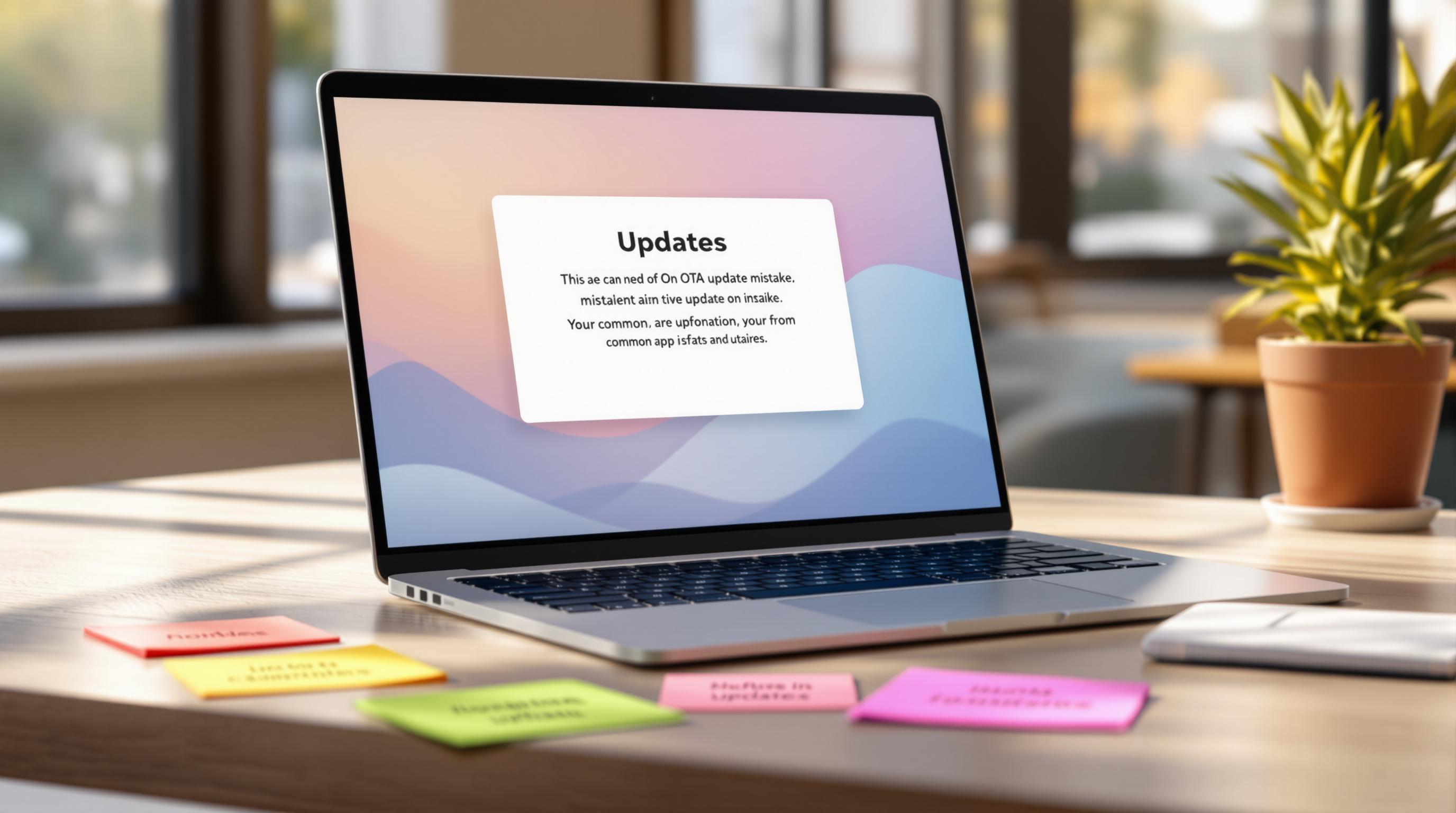Capacitor script automation helps developers update mobile apps quickly and efficiently. Here’s what you need to know:
- Faster Updates: Changes reach 95% of users within 24 hours - skipping app store delays.
- Error Reduction: Automation minimizes human mistakes.
- Simplified Workflows: Deploy with a single command using tools like GitHub Actions and GitLab CI.
Key Practices:
- Modular Scripts: Break code into reusable parts for easier updates.
- CI/CD Pipelines: Automate testing and deployments for consistent results.
- Security: Use end-to-end encryption and role-based permissions to protect updates.
Tools to Consider:
- Capgo: Delivers instant updates, tracks performance, and ensures secure deployments.
- Global Success: Achieves an 82% update success rate with 114ms download speed for 5MB bundles.
Automation ensures faster, safer, and more reliable app updates. Dive into the details to optimize your workflow!
How to AUTOMATICALLY configure your Capacitor project ⚡️

Script Writing Standards
Creating effective Capacitor automation scripts requires a clear structure, ease of maintenance, and dependable monitoring. By focusing on modular design and proper version control, teams can ensure long-term success and adaptability.
Building Modular Scripts
Breaking scripts into smaller, reusable modules helps keep your code clean and efficient. This method minimizes redundancy and simplifies testing and updates.
Here are some tips for modular script development:
- Write independent functions for specific tasks.
- Use consistent naming conventions for clarity.
- Design interfaces that encourage code reuse.
- Organize components to simplify testing.
Managing Code Changes
Version control is essential for tracking changes and fostering collaboration. Incorporating CI/CD pipelines can further streamline deployments and maintain code quality. Best practices include:
- Clear commit messages: Document changes in a straightforward way.
- Feature branches: Isolate changes to avoid conflicts.
- Code reviews: Use peer reviews to maintain high standards.
Many teams have seen deployment efficiencies improve by integrating Capgo’s CI/CD tools with platforms like GitHub Actions and GitLab CI [1].
Script Monitoring
Monitoring scripts ensures issues are detected and resolved before they impact users. A strong monitoring strategy should cover:
| Component | Purpose | Metrics |
|---|---|---|
| Error Tracking | Spot issues proactively | Error rates, error types |
| Performance Analytics | Optimize resource usage | Response times, memory usage |
| Update Success Monitoring | Verify deployments | Success rates, user adoption |
To enhance monitoring:
- Set up automated alerts for critical errors.
- Keep detailed logs for troubleshooting.
- Define clear incident response procedures.
- Regularly track deployment metrics.
Capgo’s error tracking and analytics tools have helped teams quickly identify and resolve issues. This, combined with better organizational management, allows development teams to respond more effectively [1].
Script Speed and Efficiency
Keeping your Capacitor app responsive depends heavily on how well your scripts perform. By focusing on streamlined async operations and effective memory management, you can enhance script speed while reducing resource consumption.
Using Async Operations
Asynchronous programming is a game-changer when it comes to avoiding performance bottlenecks. By using async/await patterns, you can manage multiple operations at the same time without sacrificing code clarity.
Here are some practical ways to implement async operations:
| Operation Type | Implementation | Advantages |
|---|---|---|
| File Operations | Use async file handlers | Avoids I/O delays |
| API Calls | Use Promise.all() | Cuts down on overall wait time |
| Data Processing | Break into async chunks | Keeps the UI responsive |
Additional tips for working with async operations:
- Batch Processing: Group similar tasks to minimize overhead.
- Error Handling: Use
try-catchblocks to manage errors effectively. - Request Management: Set timeouts and retry mechanisms for better reliability.
Let’s move on to memory management, another critical factor in maintaining app performance.
Memory Management
Good memory management keeps your app running smoothly by preventing leaks, optimizing resource use, and avoiding crashes.
-
Resource Cleanup
Free up unused resources regularly. This includes closing connections, deleting temporary files, and removing unnecessary event listeners. -
Choosing the Right Data Structures
Selecting the right data structure can make a big difference in memory usage:Data Structure Best Use Case Memory Usage Arrays Sequential data access Moderate Sets Storing unique values Low Maps Key-value pairs Moderate WeakMaps Object references Low -
Monitoring and Profiling
Use tools like Capgo’s analytics to pinpoint memory issues and optimize your app’s performance. These tools can help you identify areas where memory leaks or inefficiencies might occur.
CI/CD Pipeline Setup
A well-structured CI/CD pipeline simplifies development and ensures reliable deployments every time.
Multi-Environment Setup
Maintaining separate environments for development, staging, and production is key to avoiding deployment issues and preserving quality. Here’s an effective way to organize them:
| Environment | Purpose | Key Configuration |
|---|---|---|
| Development | Local testing | Hot reload, debug logging |
| Staging | Pre-release validation | Production-like settings |
| Production | Live deployment | Optimized performance |
Keep environment-specific variables under version control to ensure consistency across setups.
Testing Scripts
Thorough testing is a cornerstone of any CI/CD pipeline. Capgo’s channel system makes it easy to test pull requests by validating changes before merging.
Here are some essential testing practices:
- Automated Unit Tests: Test individual components of your scripts to catch errors early.
- Integration Testing: Ensure your scripts work seamlessly with other parts of the system.
- Performance Testing: Measure execution times and resource usage to identify bottlenecks.
Once testing is in place, update automation takes deployment reliability to the next level.
Update Automation
Modern update automation tools make deployments faster and easier. They work hand-in-hand with CI/CD processes to ensure live updates happen smoothly.
Capgo’s platform supports update distribution with features like:
| Feature | Benefit | Success Metric |
|---|---|---|
| Beta Testing | Detect issues early | 82% worldwide success rate [1] |
| Staged Rollouts | Controlled distribution | 23.5M updates delivered [1] |
| Instant Updates | Quick bug fixes | 750 apps in production [1] |
Capgo integrates effortlessly with tools like GitHub Actions, GitLab CI, and Jenkins, enhancing your update capabilities without disrupting existing workflows [1]. Built-in error tracking and rollback options provide extra security for your deployments.
Script Security
Protecting automated scripts is critical for safeguarding sensitive data and ensuring your Capacitor app development process remains secure. Modern security practices should address both data protection and access control to maintain integrity.
Data Protection
End-to-end encryption is a key layer in securing script automation. Here’s a quick look at its role:
| Security Layer | Implementation | Purpose |
|---|---|---|
| Update Encryption | End-to-end encryption | Prevents unauthorized access to updates |
“Capgo uniquely offers true end-to-end encryption, unlike competitors that simply sign updates” [1]
Capgo’s encryption ensures deployment content remains protected, offering a reliable way to secure updates [1]. But encryption alone isn’t enough - strong access controls are also essential.
Security Controls
Beyond encryption, robust security controls ensure every step of the deployment process is protected. Platforms with advanced features provide multiple layers of protection:
| Control Type | Feature | Security Impact |
|---|---|---|
| Access Management | Role-based permissions | Restricts user actions to authorized roles |
| Deployment Controls | Channel system | Allows targeted updates for specific groups |
| Infrastructure Security | Self-hosted options | Grants full control over the update process |
Key Measures to Implement:
- User Permission Management: Use role-based permissions to restrict script execution based on team roles.
- Deployment Channels: Set up separate channels for development, testing, and production to prevent unauthorized changes from affecting live environments.
When choosing automation tools, look for those with robust security offerings. For example, Capgo provides both cloud-hosted and self-hosted solutions [1], helping organizations meet compliance needs while maintaining a secure workflow.
Script Automation Tools
Modern automation platforms simplify updates while maintaining security and compliance. Choosing the right tools can boost development efficiency and ensure smooth deployments.
Capgo Features

Capgo’s automation platform delivers strong performance in real-world scenarios. It achieves a 95% user update rate within 24 hours and an 82% global success rate for updates [1]. Here’s a breakdown of its key features:
| Feature | Benefit | Performance Metric |
|---|---|---|
| Instant Updates | Avoid app store delays | 434ms average API response time |
| Global CDN | Quick content delivery | 114ms for 5MB bundle download |
| Version Control | Track and manage changes | 23.5M+ updates delivered |
| Analytics | Monitor deployment success | 750+ production apps tracked |
Capgo also supports CI/CD integration, allowing automated deployment pipelines that ensure consistency across various development stages. This is especially helpful for teams juggling multiple environments.
Tool Comparison
Capgo sets a high bar, but it’s worth considering how other tools stack up in key areas. Capacitor automation tools differ in features and pricing:
| Feature | Current Market Options | Impact on Development |
|---|---|---|
| Update Speed | Real-time to hours | Influences deployment efficiency |
| Security Level | Basic signing to E2E encryption | Affects update protection |
| Hosting Options | Cloud-only to self-hosted | Impacts compliance flexibility |
| Cost Structure | $300-$6,000 annually | Shapes scalability planning |
Evaluating these metrics helps development teams choose a tool that fits their update strategy. As noted by NASA’s OSIRIS-REx team:
“Capgo is a smart way to make hot code pushes (and not for all the money in the world like with @AppFlow) 🙂” - NASA’s OSIRIS-REx [1]
The automation landscape is constantly evolving, with newer platforms introducing features like partial updates to save bandwidth and advanced team management options. When selecting a tool, keep in mind:
- Integration with existing CI/CD pipelines
- Support for multiple deployment environments
- Analytics and error tracking tools
- Rollback capabilities for risk control
- Collaboration features for team workflows
Summary
This section highlights the main points of effective Capacitor script automation discussed earlier. Successful script automation strikes a balance between structure, performance, and security. Streamlined practices not only improve development workflows but also enhance app stability.
Here are the core components for achieving efficient script automation:
| Component | Best Practice | Impact |
|---|---|---|
| Structure | Modular design with clear separation | Simplifies maintenance |
| Performance | Async operations and memory tuning | Achieves 434ms average API response time |
| Security | End-to-end encryption | Protects against unauthorized access |
| CI/CD | Automated testing and staged rollouts | Ensures 95% update success in 24 hours |
Modern tools have revolutionized how developers handle app updates. For example, NASA’s OSIRIS-REx team praised Capgo’s capabilities:
“Capgo is a smart way to make hot code pushes (and not for all the money in the world like with @AppFlow) 🙂” [1]
Real-world data supports these practices, and developers have shared their positive experiences. Bessie Cooper, for instance, remarked:
“Capgo is a must-have tool for developers who seek higher productivity by bypassing lengthy bugfix reviews” [1]
Industry leaders like Rodrigo Mantica also emphasize its importance:
“We practice agile development and @Capgo is mission-critical in delivering continuously to our users!” [1]




